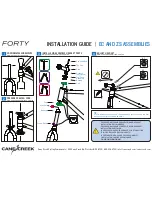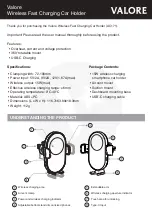
N200-06-00 1 I56-057-02R
Notifier 12 Clintonville Road, Northford, CT 06472 (203) 484-7161
This sensor must be installed in compliance with the control panel system installation manual. The installation must meet the requirements of the Authority
Having Jurisdiction (AHJ). Sensors offer maximum performance when installed in compliance with the National Fire Protection Association (NFPA); see NFPA
72..
GENERAL DESCRIPTION
Model FSL-751 is a plug-in type smoke sensor that uses a laser based photoelectronic sensing chamber. The sensor uses analog-addressable communications
to transmit smoke density and other information to the control panel.
Two LEDs on each sensor light to provide a local, visible sensor indication. Remote LED annunciator capability is available as an optional accessory (Part No.
RA400Z).
Notifier panels offer different features sets across different models. As a result, certain features of the product may be available on some control panels, but not
on others. The possible features available in the product, if supported by the control unit are:
1. The panel controls the LED operation on the sensor. Operational modes are RED blink, RED continuous, GREEN blink, and off.
2. The remote output may be synchronized to the LED operation or controlled independent of the LEDs.
Please refer to the operation manual for the UL listed control unit for specific operation of the FSL-751.
SPECIFICATIONS
Operating Voltage
Range: 15 to 32 VDC
Standby Current: 330
µ
A
@ 24 VDC (one
communication every 5 seconds
with LED blink enabled)
Max. Alarm Current (LED on): 6.5 mA @ 24 VDC
Operating Humidity Range: 10% to 93% Relative Humidity,
noncondensing
Operating Temperature Range: 0° to 38°C (32° to 100°F); U.S.
-10° to 50°C (14° to 122°F); Europe
Height: 1.7 inches (43 mm) installed
in B710LP Base
Diameter: 6.1 inches (155 mm) installed
in B710LP Base
4.1 inches (104 mm) installed
in B501 Base
Weight: 5.0 oz. (142 g)
SPACING
Notifier recommends spacing sensors in compliance with NFPA 72. In low air flow applications with smooth ceilings, space sensors 30 feet apart. For specific
information regarding sensor spacing, placement, and special applications, refer to NFPA 72 or Notifier’s
System Smoke Detector Application Guide
, available
at no charge from Notifier.
WIRING INSTRUCTIONS
All wiring must be installed in compliance with the National Electrical Code, applicable local codes, and any special requirements of the Authority Having
Jurisdiction. Proper wire gauges should be used. The installation wires should be color-coded to limit wiring mistakes and ease system troubleshooting. Improper
connections will prevent a system from responding properly in the event of a fire.
Disconnect power from the communication line before installing sensors.
All wiring must conform to applicable local codes, ordinances, and regulations.
1. Wire the sensor base (supplied separately) per the wiring diagram (Figure 1).
2. Set the desired address on the sensor address switches.
NOTE: Some panels support extended addressing. In order to set the sensor above address 99
on compatible systems, carefully remove the stop on the upper rotary switch with thumb as
shown in Figure 2.
3. Install the sensor into the sensor base. Push the sensor into the base while turning it clockwise
to secure it in place.
4. After all sensors have been installed, apply power to the control unit and activate the commu-
nication line.
5. Test the sensor(s) as described in the
TESTING
section of this manual.
CAUTION
Dust covers provide limited protection against airborne dust particles during shipping. Dust covers
must be removed before the sensors can sense smoke. Remove sensors prior to heavy remodeling
or construction.
TESTING
Before testing, notify the proper authorities that the system is undergoing maintenance, and will
A78-2461-00
Figure 1. Wiring Diagram
A78-2462-02
Figure 3.
Do not loop wire under terminal
1 or 2. Break wire to provide
supervision of connection.
CAUTION
Figure 2. Rotary Address Switches
FSL-751 Intelligent Laser Smoke Sensor
Installation and Maintenance Instructions
www.PDF-Zoo.com



















